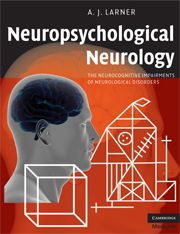Book contents
- Frontmatter
- Contents
- Acknowledgements
- Introduction
- 1 Cognitive function, neuropsychological evaluation, and syndromes of cognitive impairment
- 2 Neurodegenerative disorders
- 3 Cerebrovascular disease: vascular dementia and vascular cognitive impairment
- 4 The epilepsies
- 5 Neurogenetic disorders
- 6 Inflammatory, immune-mediated, and systemic disorders
- 7 Structural brain lesions
- 8 Endocrine, metabolic, and toxin-related disorders
- 9 Infective disorders
- 10 Neuromuscular disorders
- Index
- References
1 - Cognitive function, neuropsychological evaluation, and syndromes of cognitive impairment
Published online by Cambridge University Press: 15 December 2009
- Frontmatter
- Contents
- Acknowledgements
- Introduction
- 1 Cognitive function, neuropsychological evaluation, and syndromes of cognitive impairment
- 2 Neurodegenerative disorders
- 3 Cerebrovascular disease: vascular dementia and vascular cognitive impairment
- 4 The epilepsies
- 5 Neurogenetic disorders
- 6 Inflammatory, immune-mediated, and systemic disorders
- 7 Structural brain lesions
- 8 Endocrine, metabolic, and toxin-related disorders
- 9 Infective disorders
- 10 Neuromuscular disorders
- Index
- References
Summary
This chapter seeks to elucidate briefly the various domains of cognitive function, their neuropsychological evaluation, and syndromes of cognitive impairment. It is aimed at the practising neurologist rather than the academic neuropsychologist.
Without necessarily subscribing to an explicitly modular concept of cerebral function, it is nonetheless convenient to think in terms of cognitive domains or functional systems (‘a congeries of mental faculties’) in the brain, specifically attention, memory, language, perception, praxis, and executive function. These subdivisions, all (hopefully) working in concert, not in isolation, to produce in sum what we understand by consciousness, may direct a structured approach to the clinical assessment of cognitive function. Nowadays, a model of distributed neural networks with nodal points more specialized for certain functions has supplanted the idea of particular brain centres (Mesulam, 1990).
The neurocognitive domains may be described as either localized, implying lateralization to one hemisphere of part thereof, focal damage to which may impair that specific function; or distributed, implying a non-localized function often involving both hemispheres and/or subhemispheric structures (basal ganglia, brainstem), widespread damage being required to impair these functions (Hodges, 1994). Moreover, particular domains may be subdivided, or fractionated, into subsystems or specific functions which may be selectively impaired, suggesting the existence of functionally distinct neuropsychological substrates.
There are many tests available to the neuropsychologist for the evaluation of cognitive function, either global function or individual domains (Lezak et al., 2004; Mitrushina et al., 2005, Strauss et al., 2006). The variety of tests available may bewilder the non-specialist.
- Type
- Chapter
- Information
- Neuropsychological NeurologyThe Neurocognitive Impairments of Neurological Disorders, pp. 6 - 38Publisher: Cambridge University PressPrint publication year: 2008
References
- 1
- Cited by



